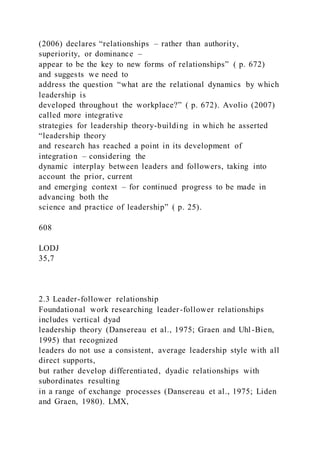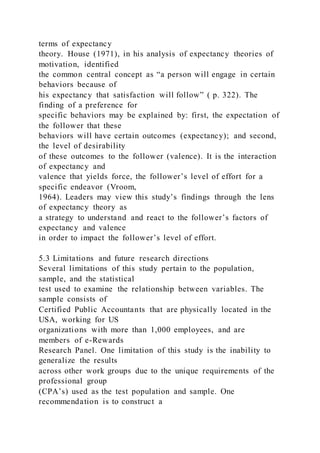This study explored the leader-follower relationship and its influence on individual performance through interviews with leaders and followers. The researcher conducted in-depth interviews with 23 participants, including 7 leaders and 16 followers, from a government agency. The interviews were analyzed and identified collaborative, partnership, and engaged relationships as major contributors to high-quality leader-follower relationships and positive influence on individual performance. The study aimed to understand how these relationships are formed, evolve over time, and impact performance from the perspectives of both leaders and followers.









































![recently tried to capture and operationalize this moral
dimension of leadership into constructs of virtue (Arjoon
2000; Cameron 2011; Dale Thompson et al. 2008; Hackett
and Wang 2012; Pearce et al. 2006). Virtues represent
attributes of moral excellence, which aggregate into an
overall dimension of virtuousness that can instill respon-
sible leadership behavior (Cameron 2011). For Greenleaf
(1977), this moral side or virtuousness was essential in
forming the core motivation to serve of the servant leader,
but it was not that morality should replace effective action,
but instead that both should co-exist and reinforce each
other. In practice, this translates into a dual mode of virtue
and action which was captured, albeit not always explicitly,
& Milton Sousa
[email protected]
Dirk van Dierendonck
[email protected]
1
Rotterdam School of Management, Erasmus University,
Burgemeester Oudlaan 50, J Building, 3062 PA Rotterda m,](https://image.slidesharecdn.com/developingtheleader-followerrelationshipperception-220921050910-58c8591d/85/Developing-the-Leader-Follower-Relationship-Perception-42-320.jpg)





























































![of the servant organizational leadership assessment (SOLA)
instrument. Dissertations Abstracts Online, 9921922.
Lewin, K., Lippit, R., & White, R. K. (1939). Patterns of
aggressive
behavior in experimentally created social climates. Journal of
Social Psychology, 10, 271–301.
Liden, R. C., Wayne, S. J., Zhao, H., & Henderson, D. (2008).
Servant
leadership: Development of a multidimensional measure and
multi-level assessment. The Leadership Quarterly, 19(2),
161–177.
Maslach, C., Schaufeli, W. B., & Leiter, M. P. (2001). Job
burnout.
Annual Review of Psychology, 52, 397–422.
Morris, J. A., Brotheridge, C. M., & Urbanski, J. C. (2005).
Bringing
humility to leadership: Antecedents and consequences of leader
humility. Human Relations, 58(10), 1323–1350.
Muthén, L. K., & Muthén, B. O. (2009). Mplus 5.21: Statistical
analysis with latent variables [computer software]. Los Angeles,](https://image.slidesharecdn.com/developingtheleader-followerrelationshipperception-220921050910-58c8591d/85/Developing-the-Leader-Follower-Relationship-Perception-104-320.jpg)










![Systems, 2622 East 21st Street, Tulsa, OK 74114; or Robert B.
Kaiser,
Kaplan DeVries Inc., 1903-G Ashwood Court, Greensboro, NC
27455.
E-mail: [email protected], [email protected], or
[email protected]
kaplandevries.com
182 April 2008 ● American Psychologist
Copyright 2008 by the American Psychological Association
0003-066X/08/$12.00
Vol. 63, No. 3, 182–196 DOI: 10.1037/0003-066X.63.3.182
ing the pursuit of those goals (cf. Bass, 1990; Hollander,
1992; Yukl, 2006). We think pragmatically of leadership as
building a team and guiding it to victory (R. Hogan et al.,
1994). Leadership is both a resource for groups and an
attribute of individuals, but we believe that its primary
significance concerns group performance (R. Hogan &
Kaiser, 2005; Kaiser, Hogan, & Craig, 2008). Given the
fitness and reproductive benefits associated with social
status (Betzig, 1993; Buss, 2005; Chagnon, 1997), the
“selfish-gene” view of evolution (Dawkins, 1976) suggests
that everyone should strive to become a leader. From this
same perspective it is not obvious why some would vol-
untarily subordinate themselves. Researchers rarely con-
sider the origins of followership, but the topic is central to
an evolutionary analysis.
Although Sigmund Freud, William James, William
McDougall, and E. L. Thorndike were enthusiastic Dar-
winians, evolutionary thinking fell out of favor in main-
stream psychology for most of the 20th century (Pinker,](https://image.slidesharecdn.com/developingtheleader-followerrelationshipperception-220921050910-58c8591d/85/Developing-the-Leader-Follower-Relationship-Perception-115-320.jpg)












![2005).
186 April 2008 ● American Psychologist
lationships. These examples suggest that species lacking
complex cognitive capacities can display follower behavior
using a decision rule as simple as “follow the one who
moves first.”
Group movement guided by leadership is also docu-
mented in nonhuman primates. Hamadryas baboons in
Ethiopia sleep in large groups on cliffs (Kummer, 1968).
They leave the cliffs in the morning to forage in open areas.
One individual, usually an adult male, will move a few
meters in a particular direction and sometimes the whole
group will follow. Sometimes, however, there are no fol-
lowers, and the would-be leader returns to the group. The
bidding starts again until the rest finally choose to follow
(Kummer, 1968). This reflects the two key decisions in the
leader game: the choice to initiate and the choice to follow.
Chimpanzees, our closest genetic relatives, often dis-
play peacekeeping, another response to a coordination
problem solved by leadership. The following incident from
the Arnhem Zoo chimpanzee colony was reported by de
Waal (1996):
A quarrel between Mama and Spin got out of hand and ended in
fighting and biting. Numerous apes rushed up to the two
warring
females and joined in the fray. A huge knot of fighting,
screaming
apes rolled around in the sand, until Luit [the alpha male] leapt
in](https://image.slidesharecdn.com/developingtheleader-followerrelationshipperception-220921050910-58c8591d/85/Developing-the-Leader-Follower-Relationship-Perception-128-320.jpg)




![Meggitt (1977, p. 76) noted,
The men who initiated the conference, or their spokesmen,
briefly
indicate their view of the clan’s position and the action they
favor.
They may argue that now is the time to launch a full-scale
attack
on the neighboring clan with the aim of occupying a specific
section of its territory. The major Big Man [the leader] then
solicits responses from the audience. Ideally, everyone present
has a voice and being among his own clansmen can speak with
complete freedom. The task of the Big Man at this stage is to
ensure that all have a chance to offer their opinions and facts in
full and to make no attempt to cut off any but obviously
irrelevant
speeches.
If the Big Men try to dominate their groups—and they
do—they meet fierce resistance from the others, who can
collaborate to control them. Dominance hierarchies are the
norm in primate groups; for early humans, collaboration
among subordinates reversed this dominance hierarchy and
resulted in a democratic leadership style that may have
existed for nearly 2.5 million years (Boehm, 1993). We
believe that the EEA reflects our natural way of thinking
about and responding to leadership, and this has implica-
tions for modern leadership practice. Modern societies still
evaluate leadership against egalitarian “hunter-gatherer”
standards such as fairness, integrity, competence, good
judgment, generosity, humility, and concern for others, and
they regard such attributes as dominance and selfishness as
the antithesis of leadership (Den Hartog, House, Hanges,
Ruiz-Quintanilla, & Dorfman, 1999; Dirks & Ferrin, 2002;
Epitropaki & Martin, 2004; Lord et al., 1984; Nicholson,
2005; Van Vugt, Hart, Jepson, & De Cremer, 2004).](https://image.slidesharecdn.com/developingtheleader-followerrelationshipperception-220921050910-58c8591d/85/Developing-the-Leader-Follower-Relationship-Perception-133-320.jpg)



















































![and theory emphasizes characteristics of the follower” ( p. 16).
Dvir and Shamir spoke to
the lack of research using followers’ characteristics as
independent variables with the
propensity for research to typically include followers’
characteristics as “dependent
variables affected by the leader [y] rather on follower
characteristics, predispositions, or
attitudes” ( p. 328). Vecchio and Boatwright (2002) spoke to the
lack of follower-focussed
research, specifically the lack of research aimed toward
understanding follower
preferences of leadership styles in their description of the state
of leadership research:
“[y] there are areas where our knowledge base remains
deficient. One of these areas is
the topic of subordinate preferences for styles of supervision” (
p. 327).
607
Perceived quality
of relationship
and preferred
leadership style
2.2 transactional and transformational leadership theories
Burns (1978) continued to build on the concept of leader -
follower relationships through
his assertion “leaders engage with followers on the basis of
shared motives and values
and goals” ( p. 36). Burns introduced his theory of leadership
bounded by the mutually](https://image.slidesharecdn.com/developingtheleader-followerrelationshipperception-220921050910-58c8591d/85/Developing-the-Leader-Follower-Relationship-Perception-185-320.jpg)

![transformational leadership being mutually exclusive), and
carries this argument even
further with the claim that the best leaders are both
transformational and transactional in
style (Bass, 1985, 1990, 1995, 1999). Bass (1998) suggests it is
transactional leadership,
through honoring commitments of contingent rewards, creates
trust, dependability,
and perceptions of consistency, which in turn form the basis of
transformational
leadership. Transformational leadership, through its focus of
idealized influence,
inspirational motivation, intellectual stimulation, and
individualized consideration
augments transactional leadership by contributing to the extra
effort and performance
of followers.
Need for further research regarding leadership theories. There
are a number
of researchers across various disciplines calling for movement
toward new ways of
looking at leadership. Maintaining the leadership elements of
leader, follower, and
relationship, researchers are suggesting a need to find new ways
of enabling the
organization. Russell’s (2003) research of leadership within
educational settings as
a relational process, suggests “whilst there is increasing
recognition of relationships in
leadership [y] followers are too frequently treated as a single
group. This suggests
leaders in the field need to be aware of the various followership
groups within their
particular organization, and their relationships and motivations”
( p. 31). Uhl-Bien](https://image.slidesharecdn.com/developingtheleader-followerrelationshipperception-220921050910-58c8591d/85/Developing-the-Leader-Follower-Relationship-Perception-187-320.jpg)





![as transactional social exchange and evolves into
transformational social exchange”
( p. 238). Gerstner and Day (1997), in their meta-analysis,
found that “Our review
supports the suggestion made by others (Graen and Uhl-Bien,
1995) that LMX should
incorporate both transactional and transformational processes” (
p. 838). Bass (1999)
describes more distinction between LMX and
transactional/transformational in
“the transactional/transformational paradigm is independent
conceptually from the
concept of leader-member-exchange (LMX), although empirical
correlation with them
may be found to some extent” ( p. 13). Although there exists a
level of disagreement
as to the exact areas of intersection between the theories, major
researchers in the field
(Bass, 1999; Gerstner and Day, 1997; Graen and Uhl-Bien,
1995) all propose there is an
intersection between some of the elements within LMX and
transactional/transformational
leadership theories, and that proposed intersection provides an
additional basis for the
inclusion of those leadership theories into this study.
Given the Bass (1999) assertion that “LMX unfolds in several
stages [y] in the first
stage, LMX is transactional. If the last stage is reached, it is
transformational” ( p. 14),
then one could reasonably expect to see some level of correlated
movements of
measurements using the LMX and MLQ instruments. In light of
these issues and calls,
this study proposed the following hypotheses:](https://image.slidesharecdn.com/developingtheleader-followerrelationshipperception-220921050910-58c8591d/85/Developing-the-Leader-Follower-Relationship-Perception-193-320.jpg)






























![47-119.
Mertens, D.M. (2005), Research and Evaluation in Education
and Psychology, 2nd ed., Sage
Publication, Thousand Oaks, CA.
About the author
Dr David Notgrass (PhD, Dallas Baptist University) is an
Assistant Professor of Management in
the College of Business Administration at the Tarleton State
University. He has previously
served as Assistant Professor of Management and Associate
Dean for the College of Business
at the Dallas Baptist University. His research interests include
leadership studies from the
perspective of the follower. Teaching specialties include
leadership studies, organizational
development and change, and organizational behavior. Prior to
entering academia, he spent 24
years with TXU including various management capacities in
customer care and information
technology. Dr David Notgrass can be contacted at:
[email protected]
To purchase reprints of this article please e-mail:
[email protected]
Or visit our web site for further details:
www.emeraldinsight.com/reprints
621
Perceived quality
of relationship
and preferred
leadership style](https://image.slidesharecdn.com/developingtheleader-followerrelationshipperception-220921050910-58c8591d/85/Developing-the-Leader-Follower-Relationship-Perception-224-320.jpg)





